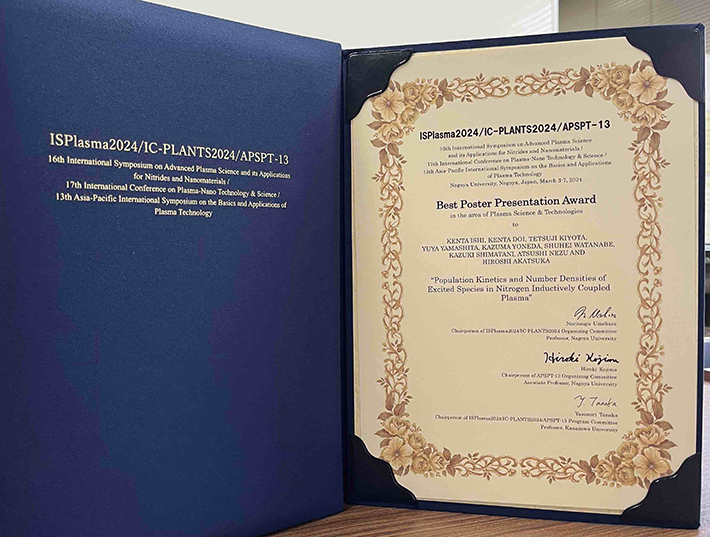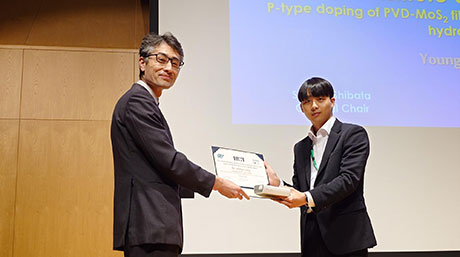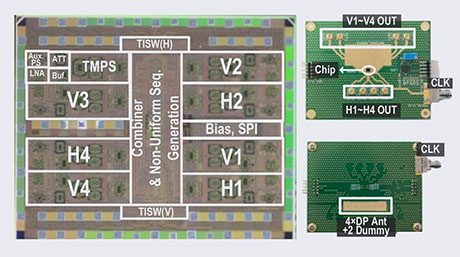Electrical and Electronic Engineering News
Tokyo Tech-ULVAC won the Best Poster Presentation Award at Int. Conf. ISPlasma2024
Spectroscopic measurements amd atomic-molecular process of N2-ICP - joint research of Tokyo Tech and ULVAC
A research group led by Kenta Ishi, a second-year master's student in the Graduate Major in Electrical and Electronic Engineering at the time, received the Best Poster Presentation Award at the international conference ISPlasma2024/IC-PLANTS2024/APSPT-13, held at Nagoya University from 3 to 7 March 2024.

Award summary
- Awardees.:
-
Kenta Ishi1, Kenta Doi2, Tetsuji Kiyota2, Yuya Yamashita1, Kazuma Yoneda1, Shuhei Watanabe1, Kazuki Shimatani1, Atsushi Nezu1 and Hiroshi Akatsuka1
1Tokyo Institite of Technology、2ULVAC, Inc. - Conferror:
- ISPlasma2024/IC-PLANTS2024/APSPT-13
- Prize:
- Best Poster Presentation Award
- Title:
- Population Kinetics and Number Densities of Excited Species in Nitrogen Inductively Coupled Plasma
- Date:
- March 7th, 2024
Comment by Associate Professor Hiroshi Akatsuka
At the Tokyo Institute of Technology's ULVAC Advanced Technology Collaborative Research Center, we are conducting joint research with the aim of advancing plasma processing equipment through emission spectroscopy measurement, focusing on reactive plasmas, which are often applied in the manufacturing processes of semiconductor integrated circuits. We are working on plasmaexperiments and theoretical modeling of excitation kinetics in the plasmas. In March 2023, our joint research was selected as a featured presentation at the spring meeting of the Japan Society of Applied Physics.
As a follow-up report, a group led by Kenta Ishi, a second-year master's student in the electrical and electronics course at the time, conducted research on the density distribution of excited states determined by emission spectroscopy experiments in nitrogen inductively coupled plasma. We improved and developed a theoretical excitation-kinetic model , and confirmed the validity of our model through comparison with experiments. The results were presented as a poster at the international conferences ISPlasma2024/IC-PLANTS2024/APSPT-13, where they were highly praised and received the Best Poster Presentation Award. Please refer to the Best Poster Presentation Award Winners section of the web page![]() .
.
It is already understood in low-temperature plasma society that in low-temperature discharge plasmas of molecular gases such as nitrogen, the electron energy distribution function (EEDF) deviates from the Maxwellian distribution. We started modeling from the respect where EEDF is described by the Boltzmann equation, which includes inelastic electron-collision processes with the vibrational population of nitrogen neutral molecules to form the vibrational distribution function (VDF). Based on the calculated EEDF and VDF, electronically-excited states must be considered their populations. I believe that the research has achieved a certain degree of success in solving this problem.
In this field of nitrogen plasma, which is crucial in the fields of electronic/semiconductor engineering, environmental engineering, and geoelectromagnetism, there is outstanding academic accumulation in European countries such as Portugal, the Netherlands, and the Czech Republic, while we were lagging behind due in part to a decrease in the number of research groups. We believe that our current research is at a level that will allow us to make up for this delay and move forward. Similar methods are expected to be applied to modeling various process plasmas in the future.
In this way, Tokyo Tech “ULVAC Advanced Technology Collaborative Research Center” ![]() are conducting joint research with the aim of improving the performance of semiconductor processing equipment. We have achieved the above results at this time, and our confidence in our research results has deepened. We will continue to make even more efforts toward further advancement and social implementation. We look forward to your continuous guidance and support.
are conducting joint research with the aim of improving the performance of semiconductor processing equipment. We have achieved the above results at this time, and our confidence in our research results has deepened. We will continue to make even more efforts toward further advancement and social implementation. We look forward to your continuous guidance and support.
Related Links
- International Conference ISPlasma2024/IC-PLANTS2024.APSPT-13 "Best Poster Presentation Award"
- International Conference ISPlasma2024/IC-PLANTS2024.APSPT-13
- Selected as a "Highlighted Presentation" at the 70th JSAP Spring Meeting|Electrical and Electronic Engineering News
- 株式会社アルバックと「アルバック先進技術協働研究拠点」を設置|東工大ニュース(in Japanese)
- Researcher Information(STAR Search)- Hiroshi Akatsuka
- Akatsuka Laboratory
- Tokyo Institute of Technology OPEN INNOVATION PLATFORM
- ULVAC inc.
School of Engineering
—Creating New Industries and Advancing Civilization—
Information on School of Engineering inaugurated in April 2016
Contact
Associate Professor Hiroshi Akatsuka
Institute of Innovative Research,
Tokyo Institute of Technology
E-mail : hakatsuk@zc.iir.titech.ac.jp






